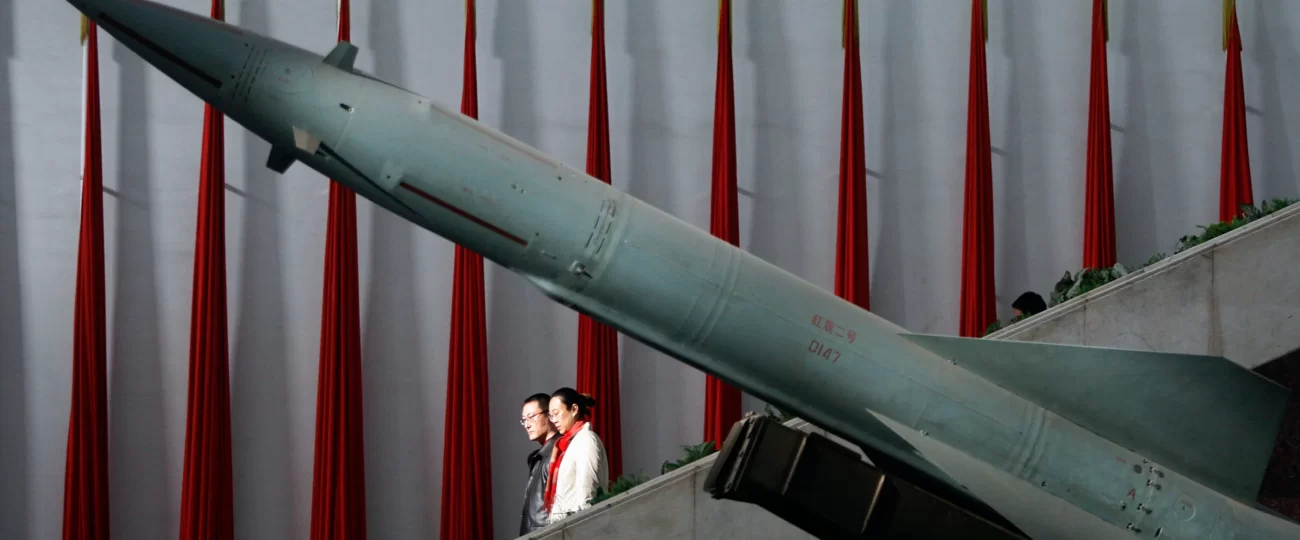The Department of Defense’s (DoD) Military and Security Developments Involving the People’s Republic of China, 2023 Annual Report to Congress was released on October 19, 2023. The threats discussed should be a wake-up call for Americans.
The report, which is an annual requirement mandated by Section 1202 of the 2000 National Defense Authorization Act, provides an authoritative assessment of military and security developments in the People’s Republic of China (PRC). The 2023 report’s findings speak to the consistent failure of Western idealism and a failure to acknowledge the oncoming threat of China.
The report is replete with alarming “takeaways” and disquieting gaps in known information about the PRC’s capabilities and current plans. The word “probably” was used 102 times within the report, indicating a nascent level of awareness so low that analysts could do little more than venture guesses or futile estimates for Congress.
Additionally, missing from this report is an acknowledgment that the PRC is likely seeking to “acquire a first-strike capability.” While garnering a first-strike capability does not always mean an intent to “go first,” for a country with a stated “no first use” policy, this nuclear arsenal expansion is distressing. By not acknowledging this perceived PRC goal, the report mutes the clarion call this report should evoke.
While this annual report has plenty to cheer and jeer, below are ten points from the report that should alarm Congress, the Biden administration, and the American people.
First, as of May 2023, the DoD estimates that the PRC has at least 500 operational nuclear warheads (p. 104). This is a significant increase from the DoD’s 2020 estimate, which placed China’s stockpile in the low 200s—with an expectation of doubling by 2030 (p. 111). This is juxtaposed by a 2012 estimate in which retired Russian generals asserted that China had enough fissile material for 3,600 nuclear warheads, with 1,600–1,800 nuclear weapons in the stockpile.
Second, the report suggests, “The PRC probably completed the construction of its three new solid-propellant silo fields in 2022, which consists of at least 300 new intercontinental ballistic missile (ICBM) silos and has loaded at least some ICBMs into these silos.” This may be the first public announcement that “some” of the completed ICBM silos are now loaded with potentially both DF-31 and DF-41 ICBMs (p. 107).
Former USSTRATCOM commander Admiral (Ret.) Charles Richard and his predecessor General (Ret.) John Hyten have both noted that the DF-41 carries up to ten warheads. When combined with the scores of road-mobile ICBMs in China’s nuclear arsenal, the number of land-based ICBM launchers exceeds the number of American land-based nuclear missiles.
During the summer of 2021, open-source researchers using commercial imagery discovered, documented, and tracked the construction of new ICBM missile silos at Yumen, Hami, and Yulin. The James Martin Center for Nonproliferation Studies at the Middlebury Institute for International Studies first identified the construction of an estimated 119 silos at the Yumen site. US Strategic Command tweeted a link to a New York Times story about the Hami discovery, a poor substitute for the requisite and timely official statement a revelation of this magnitude demanded.
Third, the PRC has approximately 350 ICBMs that can all reach the United States (p. 106). In addition to the DF-31 and DF-41, the PRC is also deploying the new DF-5C, a silo-based ICBM with a multi-megaton-class nuclear warhead (p. 107). A January 31, 2017, Bill Gertz article reported that a flight test of the DF-5C missile carrying ten warheads was conducted, which indicated the PRC “is increasing the number of warheads in its arsenal.”
Generally, megaton warheads are designed as a counter-value capability for destroying American cities. The PRC likely considers DF-5Cs as an asymmetrical advantage designed to hold American cities hostage and ransom their safety in exchange for abandoning Taiwan during forced unification.
Fourth, the newly constructed network of silo-based ICBMs is likely to operate under China’s emerging “Early Warning Counterstrike” posture. This launch-on-warning (LoW) operating concept enables a rapid counter-nuclear strike before an adversary’s first strike destroys the Chinese arsenal. The LoW concept of operations has long been vilified by American strategists as destabilizing and fraught with risk of accidental launch.
Fifth, the PRC officially established its own nuclear triad. The vintage H-6N bomber features a modified fuselage to allow an external nuclear-capable air-launched ballistic missile (ALBM) (p. 63). According to the report, the nuclear-capable ALBM “appears to be armed with a maneuvering reentry vehicle,” thus indicating the ALBM is likely capable of conducting nuclear precision strikes (p. 108). This capability and the report’s assessment indicates China is developing a nuclear warfighting approach, not just maintaining deterrence.
Sixth, the PRC may be developing a conventionally armed ICBM. If fielded, such capability would allow the PRC to threaten conventional ballistic missile strikes against the continental United States (p. 66). The report notes that conventionally armed ICBMs would present significant risks to strategic stability, which is one reason why the United States Air Force abandoned the concept.
Seventh, the PRC is likely developing advanced nuclear delivery capabilities like the fractional orbital bombardment system (FOBS) and hypersonic glide vehicles (HGV). A FOBS-HGV was tested on July 27, 2021—orbiting the earth before reentering the atmosphere to strike a target (pp. 67, 111). Chinese FOBS weaponizes outer space because it potentially places nuclear warheads into low-earth orbit prior to de-orbiting them onto their targets with the goal of evading missile defenses.
The risk to America from a realized Chinese FOBS-HGV is conspicuous. The system’s extreme range allows it to circumnavigate the planet placing any target on the face of the earth at risk, potentially from any direction. This greatly complicates an early warning system’s ability to detect, track, and target it for intercept. Moreover, once separated from the FOBS, HGVs would be very maneuverable and travel at least five times the speed of sound, “effectively reducing the defender’s warning and response time as well as understanding of the ultimate destination of the attack.” From a Western perspective, there is little deterrent value from a FOBS-HGV system other than to coerce adversary compliance amid a crisis or function as a first-strike pre-emptive attack.
Eighth, despite the PRC’s “No First Use” policy, China’s nuclear strategy likely includes consideration of a nuclear strike in response to a nonnuclear attack. As one senior People’s Liberation Army Colonel told this author on a trip to China, threatening the viability of China’s nuclear forces or command and control systems will likely elicit a nuclear response.
A recent assessment of China’s Proposal of the People’s Republic of China on the Reform and Development of Global Governance noted the omission of any “No First Use” policy while expressing other detailed positions on nuclear weapons could indicate a departure from China’s almost 60-year commitment. In 2021, the PRC sanctioned a video threat in which the narrator said, “We will use nuclear bombs first. We will use nuclear bombs continuously. We will do this until Japan declares unconditional surrender for the second time.” It appears the PRC’s “No First Use” policy remains in name only and exists only to deceive Western policymakers and nuclear disarmament advocates.
Ninth, China deploys two land-based intermediate-range ballistic missiles (IRBM), which can carry both nuclear and conventional warheads that can “hot swap” between launching the nuclear and conventional warhead variants. The purported flexibility, precision, and range of these IRBMs suggest that they are well suited to limited nuclear use against American military targets in the Pacific.
And tenth, the PRC’s continued research on toxins and pharmaceutical-based agents has both military and civilian applications, which raises concerns about its compliance with the Biological and Chemical Weapons Conventions. The United States is unable to confirm if the PRC has fulfilled its obligations under either Convention (p. 114). The probability of chemical or biological weapon employment against American forces remains a real threat.
Since the United States does not possess an in-kind chemical or biological capability with which to respond to such escalatory attacks and thus must either deter or respond with conventional or nuclear weapons, China may view its capabilities as an asymmetric advantage. Adversaries who are signatories to such treaties but are unwilling to adhere to their protocols cannot be trusted to adhere to nuclear weapons treaties or risk reduction measures.
Conclusion
The DoD’s inability to provide a confident and consistent description of China’s increasing nuclear threat for public consumption raises questions of intentional underestimation. For the Department of Defense to construct and implement a coherent strategy to counter the Chinese nuclear threat, it must first understand the adversary’s capabilities and capacities. Next, it must accurately communicate the magnitude of the threat to the American people and their congressional representatives to ensure proper support and resourcing. Then it must be prepared to “hold at risk” the newly added PRC nuclear targets without uncovering other strategic targets in other parts of the world. This may well demand additional American capability, something the Biden administration has already repudiated without sufficient explanation.
The PRC views the development of its “asymmetric countermeasures,” primarily nuclear weapons, as a “trump card” for safeguarding the PRC’s core interest of achieving unification with Taiwan (p. 181). With breathtaking speed, the Chinese are fervently and consistently building the capability and capacity needed to ensure their “freedom of movement.”
If deterring a nuclear attack by the United States was its goal, the PRC would not have spent such time and treasure expanding a nuclear force that was already successfully deterring the United States. Rather, its nuclear force is expanding rapidly to prevent America and its allies from intervening in any aggression toward Taiwan or in the South China Sea. Simply said, China seeks to restore a hierarchical international order where the Chinese Communist Party sits atop the rest of the world and American influence is severely reduced or even eliminated.
The time has come to be honest with the American people about the true nuclear threat from China. We must replace “probability” with certainty and then act realistically to defend American interests with a more aggressive deterrence posture.
Col. Curtis McGiffin (U.S. Air Force, Ret.) is Vice President for Education at the National Institute for Deterrence Studies and visiting professor at Missouri State University’s School of Defense and Strategic Studies. Adam Lowther, PhD is Vice President for Research at the National Institute for Deterrence Studies. Together, they have more than five decades of experience in uniform and DoD civil service in the nuclear enterprise. Both authors co-host the popular weekly podcast “The Nuclear View” found at https://thinkdeterrence.com/podcast-shows/.
The views expressed by the authors are their own.







